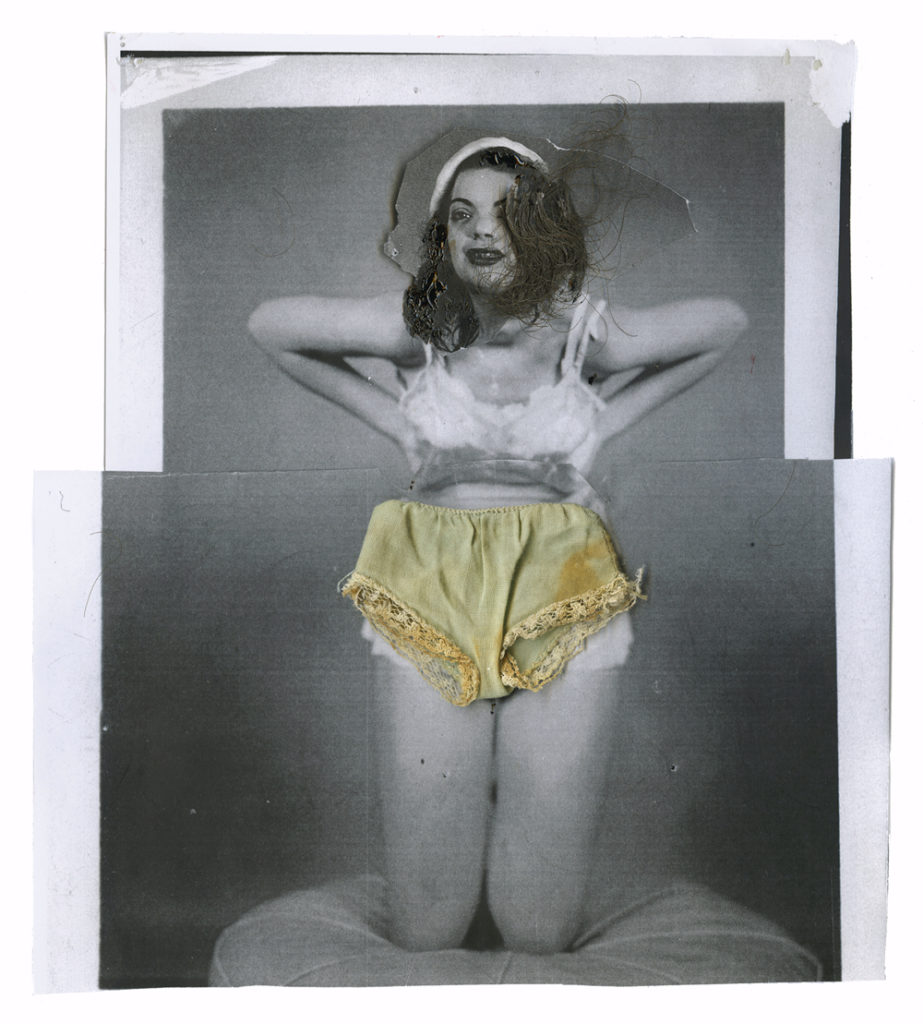In an odd moment of art-world gestalt, I happened upon a disturbing scene en route to the opening of Angela Grossmann’s “Models of Resistance,” part of the Capture Photography Festival in Vancouver. Through the lens of the Granville Street–bus window, moving slowly through the city’s perma-gridlock, I spied the dregs of a bachelor party spilling out from an old hotel. A young man wore a set of fake boobs, a single plastic breast exposed on one side, as he held and locked lips with a blow-up sex doll.
I couldn’t have asked for a more appropriate set up to an afternoon imbibing Grossmann’s new work, touted by curator Lynn Ruscheinsky as an exploration of the “role performance plays in the assumption and persistence of gender identity in a postmodern world. The emotional and vulnerable nature of these portraits ‘play’ with erotica, using the assumption of the voyeuristic gaze and the socially acceptable expectation of female behavior as a starting point.”
In many ways, Grossmann’s Models of Resistance is an Alpha Girls (her 2006 series examining teenage tribalism) for grown ups. “There’s no way I could have done an exhibition like this in my 20s,” says Grossmann, “I would have found these images repellent, grotesque.”
In fact, Grossmann’s 22 collaged images, created from photographs of old doll clothes, human hair and appendaged limbs, torsos and puppet heads, are expressions of female empowerment. There is a potency that belies their cartoon-like surfaces; spliced-in images of prosthetic limbs, sexually ambiguous body parts and found homemade erotic photography (almost innocent in its amateurism) create works that are equal parts Betty Boop, Bettie Page and Boadicea.
These are fierce creatures who dare to display imperfect, middle-aged bodies and take back the erotic gaze by staring out at the viewer in defiance. They distort the traditional peep-show aesthetic by exuding casual confidence, even indifference, while owning their bodies—despite being made of disparate, borrowed parts. “Usually, in collage it’s about juxtaposition,” explains Grossmann. “But here I wanted to make the collage work as a unified form.”
Grossmann largely succeeds, producing often “middlesex” forms that, even with the intrusion of male body parts and odd fusions of back-to-front views, feel like actual, singular entities. Inspired by the confluence of the Internet, the profusion of sexualized imagery, a blurring of boundaries and different eras warped by their endless availability on Google, Grossmann’s show could well have been another commentary on consumerism rendering us genderless. Yet the work exudes a sense of female power—albeit one that does not conform to a digitized ideal.
Among the 22 works there are some particularly memorable pieces, including Baby Doll, a kind of postmodern Pietà, where a puppet-headed woman with mannish hands breastfeeds a doll over an old-fashioned pram; Stairs, where a figure with a male torso stands suspended in a kind of threshold/portal seemingly accessed only by the initiated; Gloves, in which a woman in a man’s military-style coat sits amidst a no-man’s-land backdrop, somehow strong and statuesque as she keeps up appearances with a pair of proper white gloves; Ruffles, where a world-weary clown in retro hose emerges from an old statue; and Bunny, featuring a woman with a skewed bottom and mismatched legs who turns her back to the viewer, while, below her feet, a base of white and yellow oils lends an air of painterly nostalgia.
On a practical level, these works had their genesis during a Toronto teaching semester when Grossmann was separated from her Vancouver studio and couldn’t paint. The paper collages were something she could create in a rented living room off Dundas “without making a mess.” But once back at home base, where her incredible collection of found objects and images offered an endless supply of materials (just where does one source a stained pair of doll panties?), the project blossomed.
Back in a city where women have famously disappeared to no great alarm, there is both an urgency and an intimacy to these portraits. Just as Isis picked up the pieces of Osiris, Models of Resistance offers disparate pieces of women, made whole again by Grossmann.









